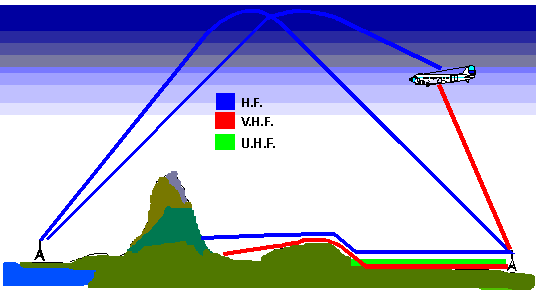Talk:Ionosphere Layers: Difference between revisions
→ham band by day or night: new section |
|||
| (One intermediate revision by the same user not shown) | |||
| Line 32: | Line 32: | ||
MF | MF | ||
* 160m : night propagation. local skip. | * 160m : night propagation. local skip. | ||
During the day the 20m band is popular. At night the 20m band will be far less active and the 40m and 80m band will become active. Overall it is thought that 20m is best for DX'ing. Some ham operators break the activity down by time of day, 20m being most active in the middle of the day, 40m in the afternoon or early evening, and 80m at night. | |||
Latest revision as of 22:33, 10 November 2015
Radio Waves
H.F. (High Frequency 3 to 30MHz)
Long Range communications. Shipping, Aircraft, World Broadcast Communications, Radio Amateurs. Use involves reflecting the signal off the ionosphere back down to waiting recieving stations. Prone to atmospheric changes causing fading and noise. Range from 500 to thousands of Kilometres.
V.H.F. (Very High Frequency 30 - 300 MHz)
Medium range communications. Fleet vehicles, mobile, coastal shipping and air to tower communications. Range 70-100km (aircraft several hundred km).
U.H.F (Ultra High Frequency 300-3000 MHz)
This is the domain of such things as Police handheld radios, cell-phones, T.V., and spacecraft to ground communications. In the high U.H.F. range the signal can "bounce" off buildings and reflect until it is detected by a receiver.
ham band by day or night
VHF
- 6m : sporadic, mostly daytime.
HF
- 10m : evening propagation and daytime mostly and during high sunspot period of solar cycle.
- 12 - 17m : daytime bands, usually opened.
- 20m : Can be opened day or night. This is a reliable band for DX.
- 40m : local skip during the day, DX at night.
- 80m : local skip during the day, longer distance DX at night.
MF
- 160m : night propagation. local skip.
During the day the 20m band is popular. At night the 20m band will be far less active and the 40m and 80m band will become active. Overall it is thought that 20m is best for DX'ing. Some ham operators break the activity down by time of day, 20m being most active in the middle of the day, 40m in the afternoon or early evening, and 80m at night.
